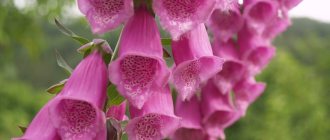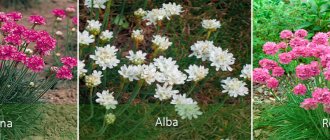Types of pyrethrum: girlish, pink and others
The exact number of types of pyrethrum has not been established, but there are several varieties that are suitable for home cultivation:
| View | Description | Flowers | Flowering period |
| Maiden | Perennial shrub from the southern regions of Europe. Branched, reaches 50 cm. The foliage is pale green, occasionally with tints of yellow. | Basket-shaped inflorescences, diameter about 4 cm. They can be regular or double. White and yellow. | Beginning of July – end of August. |
| Pink | Perennial growing in the Caucasus. It is grown as a biennial or annual. The stem is erect, with a height of up to 70 cm. It is one of the hybrid species. | Tubular or reed-shaped, bright yellow or pinkish in color. Buds up to 12 cm in diameter. | Mid-June – end of July. |
| Shield | Perennial, native to the eastern regions of Europe, the Caucasus. The trunk is straight, reaches 1 m. The basal foliage is about 40 cm long. | Inflorescences are corymbose, loose. Reed or tubular, yellow or white. | June July. |
| large-leaved | Perennial plant growing up to 1.5 m. | Small, formed into corymbose inflorescences. White, becoming reddish by mid-summer. | End of May – mid-July. |
And thanks to the fruitful work of breeders, several varieties of pyrethrum were also discovered:
| Varieties | Description | Flowers | Flowering period |
| Comedian | A hybrid with an erect trunk about 80 cm high. | Reed and tubular, bright red or yellow. | From July to August. |
| Robinson's Giants | The variety of pink pyrethrum is one of the most popular varieties of this plant. The trunk is straight, with a height of about 80 cm. Used for group plantings, ridges, and also for cutting. | Reed. Color: pink or carmine. | Mid-June – second half of July. |
| Golden ball | Derived from maiden pyrethrum, it belongs to the decorative varieties. Perennial, but in Russia it is grown as an annual. Grows up to 25 cm. | Terry, spherical in shape. Bright yellow color. | June July. |
| Troubadour Reeds. | A variety of pink pyrethrum. Used to decorate flower beds. | Color - from white to red. | The next year after sowing (mid-June). |
| Scarlet Star | Perennial plant up to 80 cm high. | Tubular (yellow) or reed (deep red). | Mid June – July. |
| Harmony | A variety of pink pyrethrum, with a 70 cm trunk. | Terry. Color – yellow or red. | Mid June – August. |

Types and varieties of pyrethrum with photos and descriptions
Gardeners cultivate not a very large number of types of pyrethrum. But it must be taken into account that such a flower has a very large number of different varieties and garden forms.
Beautiful pyrethrum (Pyrethrum pulchrum = Tanacetum pulchrum)
This species can be found in natural conditions in Northern China, Kazakhstan, Central Asia, Northern Mongolia and Siberia. This flower prefers to grow in the tundra, on rocky outcrops and slopes near glaciers. This perennial plant is rhizomatous and semi-rosette, it reaches a height of about half a meter, and on the surface there is pubescence consisting of winding hairs. A few weakly leafy shoots are erect. Green basal leaf plates have long petioles, they are double pinnately dissected, can be bare or have sparse pubescence. The length of such leaves is about 15 centimeters and the width is 2 centimeters. The stem leaf blades are sessile. The baskets can be single or included in inflorescences of 2 or 3 pieces. The baskets include tubular flowers of gray color and reed flowers of white color.
Pyrethrum macrophyllum = Tanacetum macrophyllum = Chrysanthemum macrophyllum)
The homeland of this perennial plant is the Caucasus. The height of such flowers can vary from 1 to 1.5 m. The diameter of the corymbose inflorescences is about 10 centimeters, they consist of small white flowers. When the plant begins to bloom, its baskets will change color to brown-red. This flower looks great in large groups, and it is recommended to combine it with switchgrass, variegated miscanthus, reed grass, and other ornamental cereal crops.
Growing pyrethrum from seeds
Persian or Dalmatian chamomile (another name for pyrethrum) is effectively propagated by seed. But with such dilution, the color of the buds can turn out unpredictable.
You can grow pyrethrum using seeds in the following ways:
- planting seedlings;
- direct landing in open ground.
When using seedlings, the seeds are sown in early spring, then in May the seedlings are already placed at the final growing site. Since this planting material is quite small, professionals advise mixing it with sand and then covering it with a little soil. Pots with seedlings are covered with film to create a greenhouse effect. Shoots appear within a week.
After 3 true leaves appear, the seedlings are transplanted into separate pots. For a month, provide a temperature of +20 °C.
Seeds are planted in open ground in May-June. When seedlings emerge, the seedlings are placed so that the gap between them is about 20 cm.
Growing conditions and care
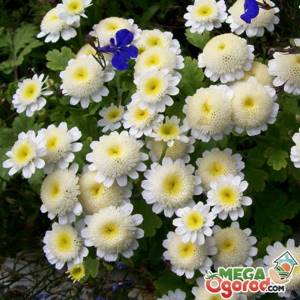
Caring for Pyrethrum is very simple. In order for the flower to grow and bloom well, it is enough to follow the minimum care rules:
- Despite the fact that Pyrethrum is unpretentious and requires almost no care, you need to regularly remove weeds from the flowerbed. This is necessary not only to maintain a beautiful and well-groomed appearance, but also for better flower growth. Weeds deplete the soil and take away nutrients; it is especially important to weed the flowerbed during the period of active growth of Pyrethrum. When the flower grows, it copes with weeds on its own, suppressing their growth.
- Pyrethrum does not need frequent watering, but if the summer is hot and dry, you need to water the plant as needed. Make sure that the soil does not dry out or crack. The plant tolerates drought well, but with a long absence of moisture, the flowers begin to become smaller and the colored buds begin to lighten. Do not abuse the durability of Pyrethrum.
- Like any garden flower, Pyrethrum needs to be fed periodically. Mineral fertilizers need to be applied to the soil four times a season. You can buy ready-made complex mineral fertilizer in granules at a gardening store. It is convenient to plant and add to the soil of flower beds.
- If you want to grow Pyrethrum as a perennial plant, take care to prepare for winter. In the fall, when the plant has faded and the seeds have been collected, you need to trim off the dry stems and faded buds. To help Pyrethrum survive the winter better, the ground around the roots is mulched with leaves or hay. If winters are harsh in your area, cover the entire plant with spruce branches. This coating will protect the flower from freezing.
- Pyrethrum maidens blooms for a very long time. After winter, perennial Pyrethrum begins to open its first buds in May-June. After this, the buds dry out and spoil the appearance of the flowerbed. If you carefully trim the flower and remove the buds, this will activate the growth of new ones, renew the plant and give the flowerbed a well-groomed appearance.
- During rain, it is recommended to lightly loosen the soil near the roots. This will allow oxygen to penetrate to the roots, and a crust will not form on the surface of the soil, which retains moisture.
Planting pyrethrum
It is recommended to sow seeds or seedlings in the ground in late spring or early summer, when the threat of frost has passed.
They prefer well-lit areas, although Persian chamomile feels comfortable in partial shade. With a lack of light, the trunks stretch, thereby reducing the abundance and duration of flowering.
The flower is undemanding when it comes to soil, but it is recommended to choose permeable soil, because Dalmatian chamomile does not tolerate stagnant water. In acidic soil, add ash or lime.
Outdoor care

In a normal summer, pyrethrum may get enough moisture from precipitation. During the dry season, the plant will require additional watering, otherwise the flowers will become smaller. Pyrethrum should be watered sparingly, without waterlogging the soil.
The plant blooms without additional fertilizing, but if you grow pyrethrum on fertile soil, it shows the best varietal qualities and forms a lush bush.
The long stems of the plant can break off from wind or heavy rain, so they should be tied up.
Pyrethrum is not overrun by weeds, so it does not require constant weeding. The soil around plant bushes is loosened after rains or watering so that a crust does not form on the surface of the soil.

In the fall, all the stems of perennials are cut off and covered. But pyrethrum can survive the winter without shelter if it is kept under a gentle cover in winter.
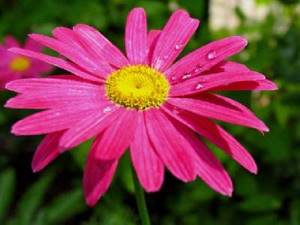
Pyrethrum is popularly known as chamomile, popovnik, or even simply chamomile. Pyrethrum belongs to the aster family. Loves open sunny places, but can also grow in partial shade. Seeds remain viable for up to 3 years. It is believed that pyrethrum flowers and seeds repel cockroaches and mice, about which a video was made and there are photos on the topic on any forum.
Pyrethrum propagation
In addition to planting seeds, the plant is propagated by dividing the bush and cuttings.
The first option for breeding pyrethrum is carried out once every 3-4 years; by this period, the flower is actively growing lateral processes. To do this, the bush is removed from the soil and excess soil is removed from it. The division is done manually. The resulting parts must be large; they are placed in holes and watered abundantly.

Cuttings are obtained from young root shoots, from late spring to August. Then they are transported to nutritious and airy soil for rooting, the container is placed in partial shade. The earth is constantly moistened, and to reduce evaporation, the shoots are covered with film. Ventilate and irrigate daily. Rooting occurs between 14 and 21 days. Then they transplant into the garden.
Growing from seeds at home
Pyrethrum is a perennial plant. In the first year, a leaf rosette and root system are formed; flowering occurs in the second year. You can grow a snow globe or others from seeds that have good reviews.
When growing pyrethrum from seeds, there is a high probability that it will not inherit the qualities of the mother plant. Therefore, it is best to propagate the variety you like by cuttings, especially since this method can be used throughout the summer, but not before winter. Selected cuttings are rooted in open ground. At first, the plants are shaded using an awning made of plastic film.
However, the easiest way to propagate pyrethrum is by dividing the bush. Division is carried out after flowering has ended. The old bush is dug up and shaken off the ground. Then it is divided into rosettes, which are placed in new places. It is advisable to mulch the soil around the transplanted plant.
Diseases and pests of pyrethrum
As pyrethrum grows, it is susceptible to insect attack and disease:
| Symptoms (effect on foliage) | Disease/pest | Corrective measures |
| Fluffy gray coating, trunk deformation. | Fusarium. | Affected flowers are removed from the ground and burned. The area where the plant was grown is treated with any fungicide. |
| Holes. | Slugs. | Collected by hand. Correct the irrigation regime, preventing water stagnation. |
| Wilting, white spotting. | Thrips. | The plant is removed from the ground and thrown away, the soil is sprayed with a systemic fungicide. |
| Yellowing. | Aphid. | In case of severe damage, pyrethrum is removed from the soil and removed from the site. If there are a small number of pests, the bush is treated with Insecticides (Aktellik, Aktara or Biotlin). The actions are repeated 2-3 times. |
Mr. Summer Resident advises: pyrethrum in landscape design
Used in carpet-type flowerbeds for edging. In this situation, the bushes are trimmed to the required height and prevent the formation of buds.
They are also used to decorate borders. Bright colors improve the appearance of borders and mixborders.
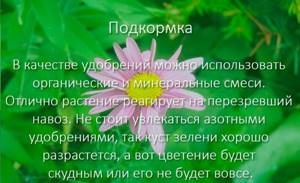
This shrub is considered the most optimal for decorating a garden in a country style. This is explained by the fact that the flower looks great and takes root nearby with ornamental plants.
The flower is used to decorate loggias and terraces. It is also suitable for arranging bouquets.
Useful properties of pyrethrum
In the old days, Dalmatian chamomile was used to lower fever, eliminate inflammation and headaches. It has been proven that this flower has properties similar to aspirin.
In the 1980s, scientists noted feverfew as an effective substance in the fight against migraines. It was said that the powder of this plant relieves severe and frequent headaches much faster than expensive medications. This was explained by the fact that the flower contains parthenolide, which helps block the synthesis of serotonin. And, as you know, excessive content of this component in brain cells and blood vessels is recognized as the cause of migraine formation.
In addition, Dalmatian chamomile blocks the production of histamine, prevents the formation of blood clots in blood vessels, and has antimicrobial and anti-allergenic properties. The leaves are used to create applications against arthritis and rheumatism, and are used to treat asthma and relieve pain during the menstrual cycle.
In combination with medications, feverfew eliminates allergic manifestations of dermatitis and psoriasis.
This plant has an unusual appearance and medicinal properties, which attracts a large number of gardeners. Decoctions from this flower are often given to young children with allergies accompanied by severe rashes.

